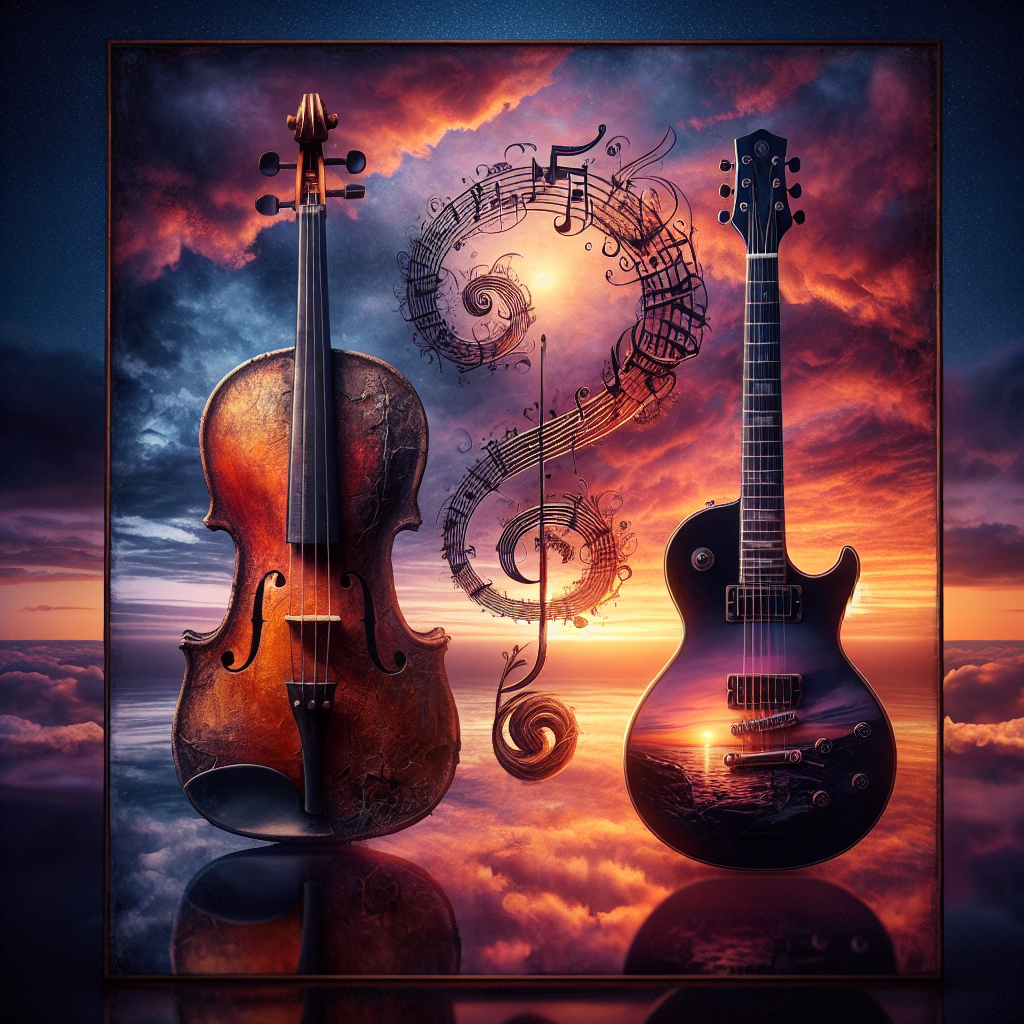The Evolution Of Inspirational Music Over Time
Picture this: you’re driving down the road, the windows rolled down, and your favorite song comes on the radio. Instantly, you feel a surge of inspiration and motivation flooding your entire being. It’s as if the lyrics of the song are speaking directly to your soul, giving you the strength to conquer any hurdle that life throws your way. Music has always had the power to touch our hearts and move us in profound ways, but have you ever wondered how inspirational music has evolved over time? From traditional hymns to modern anthems, join us as we take a journey through the rich tapestry of inspirational music and explore how it has shaped the human spirit throughout history.
Origins of Inspirational Music
Ancient religious music
Inspirational music has deep roots in ancient religious practices. From the chants of Hinduism to the biblical psalms of Judaism and Christianity, music has long been used as a tool to elevate the spirit and connect with the divine. The melodies and rhythms of these ancient religious songs were often simple yet powerful, evoking a sense of awe and reverence.
Folk traditions and spirituals
Another significant influence on inspirational music comes from folk traditions and spirituals. These genres often originated from marginalized communities and served as a form of emotional expression and resilience in the face of adversity. African-American spirituals, for example, emerged from the experience of slavery and provided comfort, hope, and a sense of community among those who endured unimaginable hardships.
Early hymns and Gospel music
Early hymns played a crucial role in shaping inspirational music. These religious songs, often accompanied by organ or choir, were widely embraced by Christian congregations. They served as a means for worship and reflection, offering a collective experience of devotion. In the late 19th and early 20th centuries, the rise of Gospel music brought a new dimension to inspirational music. Gospel music, born out of African-American churches, incorporated elements of blues, jazz, and rhythm and blues, offering a more vibrant and energetic expression of faith.
The Rise of Gospel and Christian Music
Birth of Gospel music
Gospel music emerged during the early 20th century as a fusion of religious hymns, African-American spirituals, and secular musical styles. It was characterized by its lively rhythms, soulful vocal harmonies, and the use of call-and-response patterns. Gospel choirs and soloists, such as Mahalia Jackson and Thomas A. Dorsey, popularized the genre and brought it to a wider audience.
The influence of African-American spirituals
African-American spirituals had a profound impact on the development of Gospel music. These spirituals, rooted in the experiences of slavery and the African diaspora, conveyed a mix of sorrow, hope, and liberation. Gospel music built upon this foundation, infusing it with elements of jubilation, praise, and celebration.
Innovations in hymn composition
In addition to Gospel music, innovations in hymn composition played a significant role in shaping inspirational music. Reverend Thomas A. Dorsey, often referred to as the “father of Gospel music,” introduced a new style of songwriting that incorporated both Gospel and blues influences. This innovative approach brought a fresh vitality to traditional hymns and opened the door to new possibilities within the Christian music sphere.

The Impact of Civil Rights Movement
Gospel music as a tool for activism
During the Civil Rights Movement of the 1950s and 1960s, Gospel music became an essential tool for expressing the hopes, dreams, and struggles of African-Americans in their fight for equality. Artists like Sam Cooke, who released the iconic song “A Change Is Gonna Come,” and groups like The Staple Singers used their music to inspire and mobilize audiences, providing a powerful soundtrack to the movement.
Inspirational music in the struggle for equality
Beyond Gospel music, various genres of inspirational music played a significant role in the struggle for equality. Folk artists like Bob Dylan and Joan Baez used their songs to protest social injustices, while soul and rhythm and blues artists like Aretha Franklin and Marvin Gaye tapped into the collective consciousness by singing about love, peace, and overcoming adversity.
Fusion of genres
As the Civil Rights Movement progressed, a fusion of genres began to take shape. Artists from different backgrounds and styles began collaborating, blending the sounds of Gospel, folk, soul, and rock music. This fusion allowed for a broader reach and created a shared space where people from diverse backgrounds could come together and find solace in inspirational music.
The Emergence of Contemporary Christian Music
Christian rock and pop
In the 1960s and 1970s, a new wave of inspirational music emerged within the Christian community, known as Contemporary Christian Music (CCM). Artists such as Larry Norman and Andraé Crouch pioneered the genre, infusing rock and pop influences into their music while maintaining Christian themes and messages. This shift in style attracted a younger audience and bridged the gap between secular and sacred music.
Lyrical themes and messages
Contemporary Christian Music expanded the lyrical themes of inspirational music beyond traditional religious doctrines. Artists began exploring personal struggles, relationships, and societal issues within the context of their faith. This shift allowed for a more relatable and inclusive interpretation of Christian music, fostering a deeper connection between the listener and the message being conveyed.
Mainstream success
As Contemporary Christian Music continued to evolve, it achieved mainstream success and reached audiences outside of the religious community. Artists like Amy Grant, Michael W. Smith, and DC Talk gained popularity on the secular charts, paving the way for a wider acceptance of Christian music in the mainstream music industry. This newfound visibility helped inspire a new generation of artists and listeners, expanding the reach and influence of inspirational music.

Inspirational Music in Popular Culture
Movie soundtracks and musicals
Inspirational music became a staple in the world of cinema, with movie soundtracks and musicals using music to evoke powerful emotions and enhance storytelling. Songs like “My Heart Will Go On” from the film Titanic, composed by James Horner and performed by Celine Dion, became iconic anthems of love and resilience. Musicals such as Les Misérables and Hamilton continue to move audiences with their inspirational narratives and memorable songs.
Modern pop anthems
Pop music has also embraced the power of inspiration. Artists like Katy Perry, Lady Gaga, and Beyoncé have released anthems that encourage self-empowerment, resilience, and acceptance. These songs, with their catchy melodies and empowering lyrics, have become anthems for individuals seeking motivation and affirmation.
The power of music in advertising
Inspirational music has found a new platform in advertising, where brands harness its emotional impact to connect with consumers. Advertisements often utilize uplifting and motivating songs to create a positive association with their products or messages. These carefully chosen soundtracks have the ability to captivate audiences and leave a lasting impression, emphasizing the universal appeal and influence of inspirational music.
Cross-cultural Inspirational Music
Inspirational music in different cultures
Inspirational music is not limited to a specific culture or region. In every corner of the world, diverse musical traditions carry messages of hope, spirituality, and personal growth. Whether it be the devotional qawwali music of Sufi Islam, the meditative chants of Tibetan Buddhism, or the rhythmic praise songs of Pentecostal Christianity, cultures around the globe have tapped into the power of music to inspire and uplift.
Eastern spiritual traditions
Eastern spiritual traditions, such as Hinduism and Buddhism, have long incorporated music as a means of connecting individuals with the divine. Chants, mantras, and devotional songs are used during rituals and meditation practices to create a sacred atmosphere and aid in the spiritual journey. The intricate melodies and repetitive patterns of these musical traditions create a sense of tranquility and contemplation.
World music influences
In the modern era, world music influences have found their way into inspirational music, blurring cultural boundaries and creating new expressions of spirituality. Artists like Deva Premal, blending ancient Sanskrit chants with contemporary musical styles, and Ladysmith Black Mambazo, infusing Zulu rhythms with Gospel harmonies, demonstrate the power of cross-cultural collaboration and the transformative essence of inspirational music.
The Influence of Technology and Digital Age
Emergence of online platforms
The digital age has revolutionized how inspirational music is created, shared, and consumed. Online platforms and streaming services have provided a global stage for both established and emerging artists, allowing them to reach wider audiences without the constraints of physical distribution. Artists were able to bypass traditional gatekeepers, connect directly with their fans, and explore new avenues of creativity.
Virtual worship experiences
Technology has also had a profound impact on religious practices, with virtual worship experiences becoming increasingly prevalent. Online services and live-streamed concerts have enabled individuals from different parts of the world to come together and engage in spiritual and musical practices simultaneously. This virtual connectivity has fostered a sense of unity and community despite physical distances.
The role of streaming services
Streaming services have further shaped the landscape of inspirational music by offering curated playlists and personalized recommendations. This accessibility has provided a gateway for listeners to discover new artists and genres, broadening their musical horizons. The ease of access and abundance of inspirational music available on these platforms have contributed to its continued growth and influence.
Innovations and Experimentation in Inspirational Music
Blurring genre boundaries
Inspirational music has seen a rise in experimental and genre-bending approaches. Artists like Kanye West, with his album “Jesus Is King,” and Sufjan Stevens, with his introspective folk-pop opus “Carrie & Lowell,” have pushed the boundaries of what is considered traditional inspirational music. By incorporating elements from diverse genres and embracing unconventional approaches, these artists have redefined the sound and scope of inspirational music.
Integrating contemporary styles
Inspirational music has embraced contemporary styles, merging them with its traditional foundations. Artists like TobyMac and Lecrae have seamlessly incorporated elements of hip-hop and electronic music into their work, creating a fresh and relevant sound that resonates with a wide range of listeners. This integration of contemporary styles has breathed new life into inspirational music, attracting a younger and more diverse audience.
Exploration of new soundscapes
Innovation in inspirational music extends beyond genre boundaries. Artists have begun exploring new sonic landscapes, incorporating electronic elements, symphonic arrangements, and experimental textures. This experimentation expands the sonic palette of inspirational music, enabling artists to convey a broader range of emotions and experiences.
The Role of Inspirational Music in Personal Growth
Music as a source of hope and motivation
Inspirational music has long been recognized as a source of hope, motivation, and emotional support. Its uplifting melodies and encouraging lyrics can provide comfort during difficult times and inspire individuals to overcome adversity. Whether through personal introspection or communal experiences, inspirational music has the power to ignite a sense of determination and resilience within individuals.
The psychology of inspirational music
Research has shown that listening to inspirational music can have a profound impact on the brain and emotions. It can activate the reward center of the brain, releasing feel-good neurotransmitters like dopamine. This neurochemical response can contribute to improved mood, reduced stress, and increased motivation. Inspirational music has the ability to create emotional connections and elicit powerful responses that can facilitate personal growth and self-improvement.
Self-help and motivational industries
The popularity of inspirational music has intersected with the self-help and motivational industries. Books, podcasts, and seminars often incorporate inspirational music to enhance their messages and create a more immersive experience for participants. These industries recognize the transformative potential of music and utilize its power to inspire individuals to achieve their goals and pursue personal growth.
The Future of Inspirational Music
Diversification and inclusion
The future of inspirational music lies in greater diversification and inclusion. As society becomes more interconnected and aware of different cultures, inspirational music will continue to draw influences from a variety of traditions and perspectives. This inclusivity will foster a deeper understanding and appreciation for the rich tapestry of inspirational music, allowing it to resonate with a broader audience.
Technology-driven innovations
As technology continues to evolve, so will the innovations in inspirational music. Virtual reality experiences, interactive music platforms, and artificial intelligence-generated compositions are just a few examples of how technology can enhance the creation and consumption of inspirational music. These advancements will provide new avenues for artists to express themselves and for listeners to engage with the music on a more immersive level.
Cultural shifts and social reflection
Inspirational music will always reflect the cultural shifts and social issues of its time. As society grapples with issues such as climate change, inequality, and mental health, inspirational music will serve as a medium for raising awareness, inspiring change, and offering solace in the face of adversity. It will continue to evolve, adapt, and meet the needs of individuals and communities seeking inspiration and healing.
In conclusion, the evolution of inspirational music spans centuries and transcends cultural boundaries. From its ancient religious origins to its present-day innovations, inspirational music has continually adapted and evolved to inspire, uplift, and empower individuals. Its impact can be seen in the realms of spirituality, activism, personal growth, and popular culture. As technology advances and society progresses, the future of inspirational music holds limitless possibilities, driven by diversification, technology-driven innovations, and a reflection of cultural shifts.







